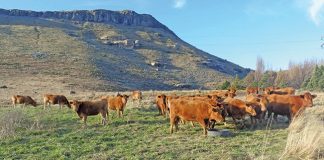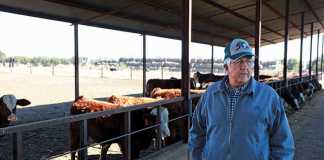
Corrie de Vos moved to his 2 324ha farm near Ermelo in 1997 and two years later established his Riccor Charolais Stud. He initially had 180 stud cows but reduced them to 100 as there was not enough demand for stud animals in his area. He also runs 400 commercial cows.
“A Charolais bull adds value to other breeds as a sire line, not a dam line,” he says. “A Charolais bull will add 30kg to the terminal slaughter weaners of any other breed such as the Brahman.” Corrie used Charolais bulls on commercial Brahman females specifically for this purpose. In addition to contributing hardiness, the Brahman also increases parasite resistance to the offspring.
But Corrie admits that with the Brahman, even the cows can be challenging to handle and at 55, he is not keen on working with such excitable cattle. During the past few years, he has also built up a commercial Beefmaster herd.
Part of the herd is kept partially purebred to assure Beefmaster replacement heifers, while others are served by Charolais bulls for the advantage of heavier weaner weights.
All these animals are then marketed commercially for slaughter. “I’ll never do away with my Charolais,” Corrie says. He clearly appreciates the calm temperament of the Charolais. “It’s a docile breed,” he says, walking up to a massive bull and stroking it without any sign of unease from its side. Cows are also far from skittish, which they prove by their relaxed demeanour as he walks among them.
Improved through breeding
Corrie says that the Charolais breed is not sensitive to the sun as many people may think. “It has a strong brown pigment around the eyes and nose, not pink skin. It’s highly adaptable and popular as far afield as the western Free State and Kalahari around Vryburg and Kuruman where it adapts well to the heat.
“The Charolais of today is the result of a 20-year breeding programme in which a medium frame and smoother hair coat were important. The calving problems of 30 years ago are a thing of the past. “Polled animals are also becoming popular, locally and abroad.”

Corrie de Vos and his wife Elsa.
Conception rate and AI
Corrie achieves a conception rate of between 85% and 92% in his stud herd through artificial insemination (AI), while his commercial cow herd achieves a 85% conception rate through natural service. For AI, he uses semen imported from France, where the breed originates from. When it was in short supply recently, he imported semen from Canada, but admits a preference for the French type, as Canadian cattle are higher on the leg with a flatter body and less prominent muscling. He uses a clean-up bull after AI, confirming paternity through DNA testing.
Semen usually costs between R300 and R400 a straw. In 2014, when French semen exports were banned due to disease, he imported English semen at R700 per straw. “At the rand-pound exchange rate, importing 50 straws was expensive,” he recalls. “I come from a dairy background and numbers matter to me.”
Corrie uses BLUP (best linear unbiased prediction) values as criteria for choosing a bull for AI. “Calving ease, milk production and muscling are the most important characteristics in breeding high-quality Charolais,” he stresses.
The cows are large while their calf birth weights are often perceived as being too high.
“It’s suggested that calf birth weight should be between 7,2% and 7,5% of the dam’s body weight,” he says. “My
cows average 640kg, indicating a calf birth weight of around 48kg. If I tell a cattleman that, he’ll say one cannot breed with a birth weight of 48kg as a bull born at 50kg won’t sell as a stud bull. But it’s actually the national average.
“I aim to put muscling on animals. In a commercial herd, cows that produce the heaviest calves also produce the most milk. A well-muscled bull sires a well-muscled weaner for the commercial cattlemen, giving him a premium in the feedlot.”
Recording and growth tests
Records from the SA Stud Book show that the Charolais, at 420 days, has the same inter-calving period as the Beefmaster and Drakensberger. “I use the SA Stud Book Logix programme to record births, performance data and request production reports,” Corrie explains. “It’s easy and requires little paperwork. My wife Elsa handles the digital aspects. It bothers me when I open a catalogue and details about the sire of a calf are missing.”
The French catalogues, however, include all the breed values of bulls listed and even suggest the value, such as weight or milk production, that a bull would pass on to its progeny in a herd. Charolais bulls are popular as sires for producing commercial weaners for the feedlot sector. For this reason, Corrie conducts Phase-D growth tests on every crop of young bulls to identify the best-growing bulls for commercial cattlemen.
“Those that don’t perform are slaughtered and never sold to my neighbour for breeding,” he quips.
France has two million registered Charolais cows and tests 500 bull calves annually for meat quality in what Corrie says is the best progeny test in the world. Every year, 500 French bulls are taken into the progeny test programme for AI purposes. Their progeny are also tested for growth and meat quality. Daughters are tested for maternal qualities such as calving ease and milk production.
Cash flow
Corrie recalls that a number of years ago, a friend of his who had suffered considerable losses on his farm worked out that a farmer should sell something every month to maintain cash flow. “This is difficult in a beef operation because one sells only once or twice a year. The heart of every farming operation is a healthy cash flow. I’ve followed this principle since the 1990s. It’s logical but easier said than done,” he explains.
Corrie used to plant potatoes in August and harvest them between January and April. Now he plants maize, soya beans and sugar beans between October and November. Sugar beans give him cash flow for three to four weeks in April. After that, come soya beans, giving three to four weeks of income. In June, he harvests maize. He usually sells weaner calves in March or April, but sometimes feeds and sells them later.
“I select old cows for culling after winter and market them in August or September,” he adds. “I also run some sheep and weaning lambs in August, feeding and then marketing them in October or November.”
Corrie says that this cash flow gets him through the year, which is important to make his operation work. “I operate my own transport and have a good relationship with SIS Feedlot in Middelburg, where I deliver weaner calves. I also have a good relationship with the local abattoir.”
Feed
Corrie mapped out the farm and its soil in 2000 and established weeping lovegrass (Eragrostis curvula) in the areas with lower-potential soil. From this, he bales hay from January – around 4 000 to 5 000 bales per season – and sells it from July to October. He has a multi-year contract with Pannar to harvest ryegrass seed.
“I utilise the pasture during winter, withdraw animals from October and then harvest seed for sale in January.”
In the last two years, he has moved away from ryegrass and now uses NCD Grazer from KT2. “I still withdraw animals in October and harvest seed on contract. It helps as we need a lot of feed for cows calving in winter. Our fertiliser is financed by the sales,” he says.
He uses Molatek concentrate lick and Beesvet33 to round off the bulls. NCD Grazer requires less water than other grass pastures, which is an important consideration. Corrie adds that although water may not be lacking in the area, it is not abundant. The stud and commercial heifers must perform on the veld.
“I try never to overgraze,” he says. “This is an issue throughout South Africa – I’ve noticed that most parts of the country are overgrazed.” Heifers on pasture receive a phosphate lick as supplement in summer. When winter approaches, veld animals receive protein supplements. During winter, they graze on maize stover.
Cows with young calves get a production lick and in summer graze on veld. They are transferred to NCD Grazer in October. The pasture is then left to grow out in November and December. Mowing and baling hay takes place in January and February. Cows also receive Eragrostis hay before being put to pasture.
Back-up
Support from one’s breed society is crucial for any farming operation, says Corrie. A new breeder can learn the correct breed parameters from the society and see other animals first hand.“Although we’ve had a few problems in the past couple of years, we’re now going in the right direction,” he says. “We held a successful national auction in Kroonstad earlier this year.”
Phone Corrie de Vos on 082 388 3008 or email [email protected].













